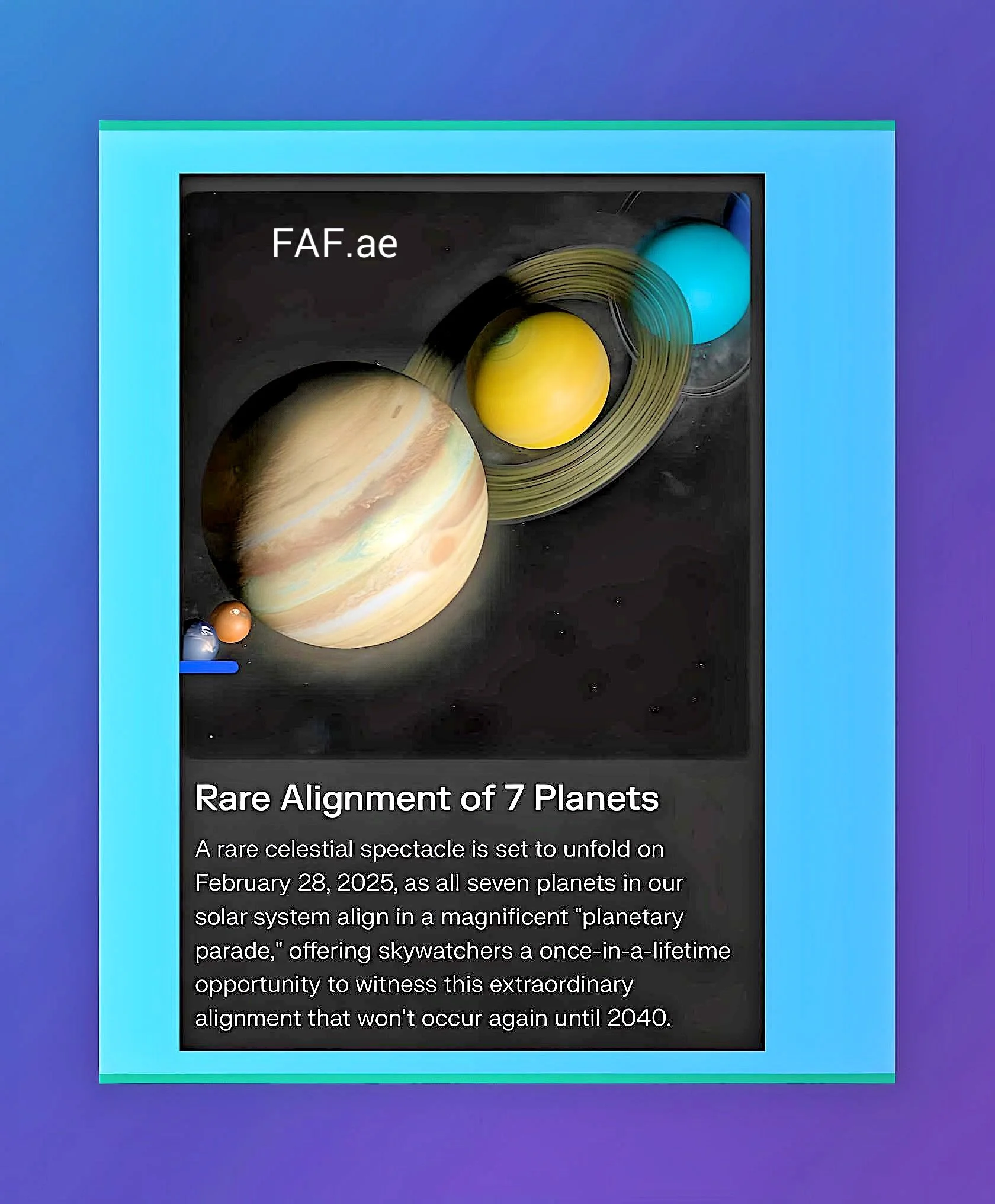Seven-Planet Alignment on February 28, 2025: A Rare Celestial Spectacle
Introduction
On February 28, 2025, a rare alignment of seven planets—Saturn, Mercury, Neptune, Venus, Uranus, Jupiter, and Mars—will grace the night sky, forming a striking arc along the ecliptic (the Sun’s apparent path).
This event, often termed a “planet parade,” will not recur until 2040, making it a must-see for stargazers and astronomers alike.
Here’s a detailed breakdown of what to expect and how to observe this phenomenon.
Key Details of the Planetary Alignment
Planets Involved
Mercury: Visible near the western horizon at sunset (mag -1.2).
Venus: The brightest planet (mag -4.8), shining in Pisces.
Mars: Reddish and high in the Gemini southern sky (mag -0.4)
Jupiter: Second brightest (mag -2.3), located in Taurus.
Saturn: Golden-hued and low near the Sun (mag 1.1) in Aquarius.
Uranus: Faint (mag 5.8) in Aries; visible with binoculars.
Neptune: Dim (mag 7.8) in Pisces; requires a telescope.
Visibility and Timing
Best Dates: February 23–28, 2025, peaking on February 24–25 in most regions.
Viewing Window: Begins 15–90 minutes after sunset, depending on location.
Regional Variations:
Tokyo: Optimal on February 22.
New York/London: February 25–March 2.
Sydney/São Paulo: March 3–4.
Observing the Alignment
Naked-Eye vs. Telescope
Visible Without Aid: Venus, Jupiter, Mars, Mercury, and Saturn (though Saturn requires precise timing due to its proximity to the Sun).
Require Optical Aid: Uranus and Neptune.
Optimal Conditions
New Moon: Coincides with the alignment, ensuring darker skies.
Weather: Clear skies are essential. Use apps like Star Walk 2 to check visibility and planet positions.
Light Pollution: Seek dark-sky locations for the best view.
Viewing Tips
Face South: Planets form an arc from the west (lower) to the east (higher).
Use Binoculars/Telescopes: Enhance the visibility of Uranus and Neptune.
Mercury and Saturn: Observe quickly after sunset, as they set earliest.
Scientific and Observational Significance
Why This Alignment Matters
Rarity: The next seven-planet alignment visible from Earth will occur in 2040.
Ecliptic Plane: The planets align along the Sun’s path due to the solar system’s formation from a protoplanetary disk.
Research Opportunities: Scientists study such events to refine orbital mechanics and gravitational interactions.
Common Misconceptions
Straight Line Myth: Planets form a curved arc, not a straight line, due to their orbital plane.
Astrological Myths: Alignments are purely visual and do not influence Earth’s gravity or events.
Future Alignments and Conclusion
Upcoming Planetary Parades
August 10, 2025: Six planets (Mercury, Venus, Jupiter, Uranus, Neptune, Saturn) at dawn.
February 28, 2026: Six planets in the evening sky.
September 8, 2040: Five naked-eye planets + Moon.
Final Thoughts
This alignment offers a unique chance to witness the solar system’s architectural harmony.
While Mercury and Saturn pose viewing challenges, the event’s rarity and grandeur make it worthwhile.
Whether using binoculars or the naked eye, stargazers are encouraged to seize this celestial milestone before the next opportunity in 2040.
Pro Tip
Use astronomy apps like Star Walk 2 or SkySafari to track planet positions in real-time based on location.






